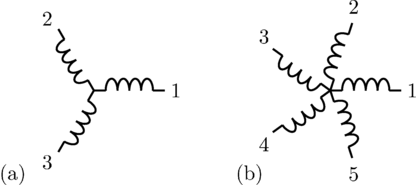MultiPhase
Multi phase windings
![]()
Library
Modelica/Magnetic/FundamentalWave/UsersGuide
Description
Symmetrical three phase system
Symmetrical three phases systems of currents (or voltages) consists of three sinusoidalsine waves with an angular displacement of .
.
 ,
,
Electrical three phase machines have (usually) symmetrical three phase windings whichexcite spatial magnetic potential with a spacial displacement of - with respect to the fundamental wave,see [Laughton02].Such a symmetrical three phase system of currents (or voltages) can be represented byphasors, as depicted in Fig. 1(a).The associated three phase winding is depicted in Fig. 2(a). The winding axis are displaced by
- with respect to the fundamental wave,see [Laughton02].Such a symmetrical three phase system of currents (or voltages) can be represented byphasors, as depicted in Fig. 1(a).The associated three phase winding is depicted in Fig. 2(a). The winding axis are displaced by :
:

So there is a strong coherence between angular displacement in the time andspatial domain which also applies to multi phase systems.
 |
 |
Symmetrical multi phase system
In symmetrical multi phase systems odd and even phase numbers have to be distinguished.
Odd number of phases
For a symmetrical multi phase system with  phases the displacement in the time and spatial domain is
phases the displacement in the time and spatial domain is ,as depicted in Fig. 1 and 2.
,as depicted in Fig. 1 and 2.
Mathematically, this symmetry is expressed in terms of phase currents by:

The orientation of the winding axis of such winding is given by:

Even number of phases
In the current implementation of the FundamentalWave library, phase numbers equalto the power of two are not supported. However, any other multi phase system with evenan phase number,  ,can be recursively split into various symmetrical systems with odd phase numbers, as depicted in Fig. 3 and 4.The displacement between the two symmetrical systems is
,can be recursively split into various symmetrical systems with odd phase numbers, as depicted in Fig. 3 and 4.The displacement between the two symmetrical systems is .A function for calculating the symmetricOrientation is available.
.A function for calculating the symmetricOrientation is available.
 |
 |
Note
In a fully symmetrical machine, the orientation of the winding axes and the symmetrical currents (or voltages)phasors have different signs; see Fig. 1 and 2 for odd phase numbersand Fig. 3 and 4 for even phase numbers.